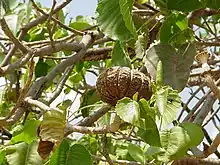Hura polyandra
Hura polyandra is a species of tree native to various parts of Latin America.[2]
| Hura polyandra | |
|---|---|
 | |
| Scientific classification | |
| Kingdom: | Plantae |
| Clade: | Tracheophytes |
| Clade: | Angiosperms |
| Clade: | Eudicots |
| Clade: | Rosids |
| Order: | Malpighiales |
| Family: | Euphorbiaceae |
| Genus: | Hura |
| Species: | H. polyandra |
| Binomial name | |
| Hura polyandra | |
In 2019 the IUCN classified this species as least concern due to there being no recent evidence of significant threats or future ones, as well as its large distribution and population.[1]
Trees can grow up to 30 meters in height[1] and its flowers are monoecious with absent petals.[3] The species occurs in cleared agricultural areas, forest plains, and rocky hillsides.[1]
References
- "Hura polyandra". IUCN Red List. Retrieved 29 December 2022.
- "Hura polyandra Baill. | Plants of the World Online | Kew Science". Plants of the World Online. Retrieved 2022-12-29.
- AZ, Tucson Richard Stephen Felger Executive Director Drylands Institute; Program, University of Arizona Matthew Brian Johnson Program Manager and Curator Desert Legume; AZ, Tucson Michael Francis Wilson Research Director Drylands Institute (2001-03-31). The Trees of Sonora, Mexico. Oxford University Press, USA. p. 149. ISBN 978-0-19-976127-2.
This article is issued from Wikipedia. The text is licensed under Creative Commons - Attribution - Sharealike. Additional terms may apply for the media files.
